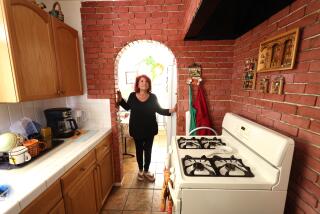Pasadena Freeway Is Headed for Immortality
- Share via
On those rare times when cars in back let him get away with it, Andrew Johnston likes to slow down and admire the treasures hidden along the freeway.
Over there are the stylized concrete railings that seem to have been crafted by artisans, not engineers. Up ahead is the unusual “compressed cloverleaf” that was once hailed as a traffic breakthrough. At the edge of the pavement are the remnants of ruby glass reflectors and curb lights that used to be so ahead of their time.
Those are some of the distinguishing touches of the West’s first freeway, the eight-mile stretch that meanders through the Arroyo Seco to connect Los Angeles with Pasadena.
Johnston, a 33-year-old Berkeley architect, is part of a federal team of eight architects, historians and artists creating a historic record of how the Pasadena Freeway looked when its first segments opened in 1940.
Their report--including two dozen large drawings that document the design of the freeway--will be placed in the Library of Congress in Washington. Copies will be used by coming generations of Caltrans engineers to guarantee that future changes to the freeway do not further destroy its original look.
The three-month research effort has shown that, except for some new sound walls and a battered steel safety barrier that now lines its center divider, not much has changed since the gracefully curved and lushly landscaped road was built over a 15-year period, Johnston said.
The $100,000 survey is part of the Historic American Engineering Record project. That is a 30-year effort by the National Park Service and professional engineering groups to chronicle pioneering public projects across the country. Bridges, old steel factories and power stations have been previous documentary projects.
Although some current-day drivers grumble about its curves and sometimes frightening offramps, engineering professionals have long admired the Pasadena Freeway. In fact, the American Society of Civil Engineers has saluted it as the prototype for this country’s modern urban freeways.
On Friday, society leaders will join Caltrans officials to unveil a plaque that designates the freeway as a “National Historic Civil Engineering Landmark.” The 10:30 a.m. ceremony will be held at 4605 N. Figueroa St.
The Pasadena Freeway, originally called the Arroyo Seco Parkway, was a marvel of innovation. Engineers combined concrete and asphalt paving and created new types of signs, safety systems and specially banked curves for the six-lane divided highway, members of the historic survey team have discovered.
“One can travel this highway with the assurance that a car will not suddenly emerge from a side street or cross over the center line and approach ‘head on,’ ” bragged district highway engineer S.V. Cortelyou in a 1940 magazine article uncovered by the researchers.
Highway engineers experimented with various onramp and offramp configurations on the new parkway.
One result was the “compressed cloverleaf” still found at the York Street exit, which today’s higher-speed motorists find maddeningly tight, according to team architect Christopher Dalbey, 23, of Manhattan Beach.
Ramps with more room for acceleration and deceleration were tried at exits like Orange Grove Avenue. What Dalbey describes as a combination of the short and long ramps was built at Avenue 43.
Sydney Mainster, a 19-year-old architecture undergraduate student at UC Berkeley, was surprised to learn that the northbound freeway’s four Elysian Park tunnels were built between 1931 and 1935 to carry two-way traffic as part of Figueroa Street. The tunnels were taken over by the freeway in 1943.
“It’s a different experience driving on the freeway now that I know how it was constructed,” said Mainster, of Agoura Hills. “I think we know now that we need to preserve the integrity of this road.”
Working out of Pasadena federal courthouse space loaned by Circuit Judge Harry Pregerson, team members such as 28-year-old Seattle architect Chris Brown are using microfilm of original freeway construction drawings and interviewing longtime Caltrans engineers.
The team’s sketches are being drawn by hand on archival-quality Mylar that is designed to last 500 years, according to group member Arabella Gonzalez, 29, an artist and preservation architect from Guadalajara. In keeping with the era, the work has an Art Deco look.
The completed sketches, photographs and an accompanying 80-page written report will be turned over to federal and state officials on Aug. 12. The work will also be on public display between 9 and 11:30 a.m. that day in room 1138 at the state office building at 107 S. Broadway, said Diane Kane, a Caltrans architectural historian.
Team historian Phil Gruen, 30, a UC Berkeley graduate student, said the freeway survives as a tribute to engineers who tried to build a highway that would be both high-speed and scenic.
And it’s also a monument to Depression-era citizens of the Los Angeles area, according to Portia Lee, another historian.
Unlike the current squabble over the Long Beach Freeway extension through South Pasadena, there was surprising unanimity about the Arroyo Seco.
“The amazing thing is how city agencies, parks people and property owners worked together for a common goal back then,” said Lee, a longtime Los Angeles resident.
Although the flashing amber safety beacons and ruby reflectors embedded in freeway curbing are long gone, architect Johnston said another thing has changed in the Arroyo Seco since 1940: speed.
“Back then they had to educate people how to use the freeway,” he said. “They had to tell people to drive faster.”
These days Johnston wishes he could tell them to drive slower.
More to Read
Sign up for Essential California
The most important California stories and recommendations in your inbox every morning.
You may occasionally receive promotional content from the Los Angeles Times.











